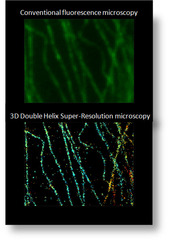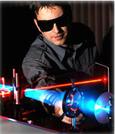Highlight
University of Colorado students develop innovative techniques in 3D nanoscopy
Achievement/Results
Integrative Graduate Education and Research Training (IGERT) students at the University of Colorado led by Prof. Piestun have developed three-dimensional microscopy techniques with super-resolution capability and single molecule sensitivity. Such microscopy techniques are creating opportunities to explore sub-cellular structure and function or to visualize materials at the nanoscale. Single-molecule photo-activation and photo-switching localization based microscopy has been recently proposed for far-field super-resolution imaging. Techniques such as PALM (Photo-Activated Localization Microscopy) and STORM (Stochastic Optical Reconstruction Microscopy) achieve super-resolution by allowing only a sparse, random set of molecules to emit light at any given time and then localizing each molecule with great precision. The latest extension by the Colorado team to three dimensions has opened up unprecedented possibilities to investigate the organization of cells.
The work performed by Sean Quirin, Prasanna Pavani, and Ginni Grover, students of the IGERT program in Computational Optical Sensing and Imaging, has been published in the Proceedings of the National Academy of Sciences and the Optical Society journals Optics Express and Optics Letters. The research reveals that proper engineering of the three-dimensional (3D) response of the optics improves 3D molecule position estimation and hence imaging resolution. In particular, the technique creates double-helix shaped light beams for every fluorescent molecule. The team succeeded in attaining unprecedented performance, reaching the fundamental limits of precision. The researchers are collaborating with biologists Jennifer DeLuca and Keith DeLuca from the Colorado State University. The efforts to develop super-resolution microscopy techniques have been recently expanded to include IGERT students Anthony Barsic from Electrical Engineering and Kevin Dean from Prof. Amy Palmer’s Biochemistry group. These interdisciplinary interactions have been made possible by the multiple integrative activities of the IGERT program sponsored by the National Science Foundation (NSF).
Address Goals
The techniques developed by the CU-Boulder team to enhance the resolution of an imaging system beyond the limitations set by the diffraction of light are key to the development of next-generation microscopes and other optical instruments. The Double Helix optical technique combines 3D optics and unique mathematical and signal post-processing algorithms. These advances offer a major opportunity to provide multifunctional 3D super-resolution imaging capability to thousands of cellular, molecular biology and biophysics laboratories in the United States and around the world. Furthermore, the Double Helix technology platform is applicable to a variety of scientific, industrial and consumer applications, including microscopy, metrology and computational digital photography. Therefore, the University of Colorado Technology Transfer Office is sponsoring the launching of a startup company, Double Helix, LLC, to help disseminate and commercialize the technique. Entrepreneurship is in fact becoming a tradition in the COSI-IGERT, with three companies started on the basis of technologies developed by IGERT students: Chiaro Technologies, Lambdametrics, and Double Helix LLC are representative of the innovative spirit instilled in the program.







